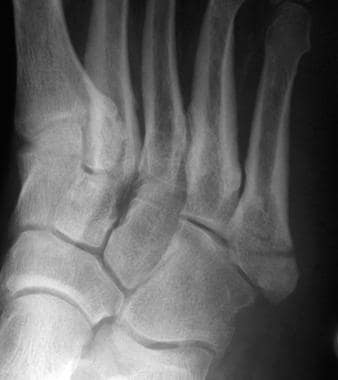Practice Essentials
Approximately 10% of all fractures occur in the 26 bones of the foot. These bones comprise 2 bones in the hindfoot (calcaneus, talus), [1, 2] 5 bones in the midfoot (navicular, cuboid, 3 cuneiforms), and 19 bones in the forefoot (5 metatarsals, [3, 4, 5] 14 phalanges). In addition, the foot contains sesamoid bones, most commonly the os trigonum, os tibiale externum, os peroneum, and os vesalianum pedis. Their smooth sclerotic bony margins and relatively consistent locations help distinguish them from fractures. Hindfoot connects to the midfoot at the Chopart joint; forefoot connects to the midfoot at the Lisfranc joint. [6, 7, 8]
Foot fractures are among the most common foot injuries evaluated by primary care physicians, most often involving the metatarsals and toes. [9, 10, 11] Diagnosis requires radiographic evaluation, but ultrasonography has also proven to be highly accurate. If any of the following are present, a radiograph is required: point tenderness over the base of fifth metatarsal; point tenderness over the navicular bone;iInability to take 4 steps, both immediately after injury and in the ED. [12]
Management is determined by the location of the fracture and its effect on balance and weight bearing. [13]
Treatment approaches include the following [13] :
-
Metatarsal shaft fractures are initially treated with a posterior splint and avoidance of weight-bearing activities; subsequent treatment consists of a short leg walking cast or boot for 4-6 weeks.
-
Proximal fifth metatarsal fractures have different treatments depending on the location of the fracture. A fifth metatarsal tuberosity avulsion fracture can be treated acutely with a compressive dressing, then the patient can be transitioned to a short leg walking boot for 2 weeks, with progressive mobility as tolerated after initial immobilization.
-
A Jones fracture has a higher risk of nonunion and requires at least 6-8 weeks in a short leg non-weight-bearing cast; healing time can be as long as 10 to 12 weeks.
-
Great toe fractures are treated with a short leg walking boot or cast with toe plate for 2-3 weeks, then a rigid-sole shoe for an additional 3-4 weeks. Lesser toe fractures can be treated with buddy taping and a rigid-sole shoe for 4-6 weeks.
-
Lisfranc injuries can be categorized as stable or unstable. Stable Lisfranc injuries can be immobilized in the ED and patients discharged home, but unstable injuries require an orthopedic referral for consideration of surgical fixation.
Below is an example of a common fracture.
 Fractures, foot. Proximal fifth metatarsal avulsion fracture (also termed pseudo-Jones, tennis, or dancer fracture).
Fractures, foot. Proximal fifth metatarsal avulsion fracture (also termed pseudo-Jones, tennis, or dancer fracture).
For patient education resources including crutch walking instructions, see the Breaks, Fractures, and Dislocations Center, as well as Broken Foot.
Epidemiology
In contrast to adults, children have relatively stronger ligaments than bone or cartilage. As a result, fractures are more common than sprains in children. However, a child's forefoot is flexible and resilient to injury. When metatarsal or phalangeal fractures do occur, they may be difficult to recognize because of multiple growth centers. In such cases, comparison views of the uninjured foot often are helpful. Persistent foot pain in children should raise the physician's concern for potentially important fractures, even in the absence of plain radiographic signs. [14]
In pediatric patients, foot tractures account for approximately 5-13% of all fractures. Toe fractures in children represent the most common foot fractures in the pediatric age group, accounting for as many as 18% of foot fractures. Phalangeal fractures represent 3-7% of all physeal fractures and are usually Salter-Harris type I or type II injuries. Pediatric phalanx fractures are more common in boys than girls and are most commonly closed injuries. [15]
-
Fractures, foot. Proximal fifth metatarsal avulsion fracture (also termed pseudo-Jones, tennis, or dancer fracture).
-
Fractures, foot. Jones fracture of the fifth metatarsal.
-
Fractures, foot. Lisfranc fracture-dislocation.
-
Fractures, foot. Calcaneal fracture with intraarticular involvement and joint depression.
-
Fractures, foot. Calcaneal fracture with intraarticular involvement and joint depression with Böehler angle imposed. Reduced angle of 16 degrees is pathologic.
-
Fractures, foot. Subtle fracture of the first cuneiform at the Lisfranc joint. Another fracture at the base of the first metatarsal is not seen here but was found on subsequent computed tomography.
-
Fractures, foot. CT scan showing fracture of first cuneiform and proximal first metatarsal.
-
Fractures, foot. Spiral fracture of the shaft of the fifth metatarsal. This fracture was treated conservatively with immobilization.
-
Fractures, foot. Minimally displaced fracture of the distal fifth metatarsal. This fracture was treated conservatively with immobilization in a rigid flat bottom shoe.
-
Fractures, foot. Two fractures of the proximal phalanx of the great toe. The fracture at the base is obvious, but the fracture at the head is more subtle. Make certain to examine every bone on the radiograph to avoid being distracted by obvious finding.
-
Comminuted navicular fracture in a young drunk driver involved in a motor vehicle crash. The patient sustained no other injuries and was discharged in a plaster splint with strict nonweightbearing. The patient subsequently had a computerized tomography (CT) scan and underwent open reduction and internal fixation 9 days after the injury. A standard anteroposterior (AP) view is shown here.
-
An added oblique view of this same patient with a navicular fracture was performed in the ED to help verify the absence of other significant fractures. Obtaining views that are not part of the routine foot series can be helpful and should be added when needed.










